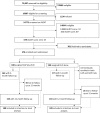Sustained effectiveness and cost-effectiveness of Counselling for Alcohol Problems, a brief psychological treatment for harmful drinking in men, delivered by lay counsellors in primary care: 12-month follow-up of a randomised controlled trial
- PMID: 28898239
- PMCID: PMC5595289
- DOI: 10.1371/journal.pmed.1002386
Sustained effectiveness and cost-effectiveness of Counselling for Alcohol Problems, a brief psychological treatment for harmful drinking in men, delivered by lay counsellors in primary care: 12-month follow-up of a randomised controlled trial
Abstract
Background: Counselling for Alcohol Problems (CAP), a brief intervention delivered by lay counsellors, enhanced remission and abstinence over 3 months among male primary care attendees with harmful drinking in a setting in India. We evaluated the sustainability of the effects after treatment termination, the cost-effectiveness of CAP over 12 months, and the effects of the hypothesized mediator 'readiness to change' on clinical outcomes.
Methods and findings: Male primary care attendees aged 18-65 years screening with harmful drinking on the Alcohol Use Disorders Identification Test (AUDIT) were randomised to either CAP plus enhanced usual care (EUC) (n = 188) or EUC alone (n = 189), of whom 89% completed assessments at 3 months, and 84% at 12 months. Primary outcomes were remission and mean standard ethanol consumed in the past 14 days, and the proposed mediating variable was readiness to change at 3 months. CAP participants maintained the gains they showed at the end of treatment through the 12-month follow-up, with the proportion with remission (AUDIT score < 8: 54.3% versus 31.9%; adjusted prevalence ratio [aPR] 1.71 [95% CI 1.32, 2.22]; p < 0.001) and abstinence in the past 14 days (45.1% versus 26.4%; adjusted odds ratio 1.92 [95% CI 1.19, 3.10]; p = 0.008) being significantly higher in the CAP plus EUC arm than in the EUC alone arm. CAP participants also fared better on secondary outcomes including recovery (AUDIT score < 8 at 3 and 12 months: 27.4% versus 15.1%; aPR 1.90 [95% CI 1.21, 3.00]; p = 0.006) and percent of days abstinent (mean percent [SD] 71.0% [38.2] versus 55.0% [39.8]; adjusted mean difference 16.1 [95% CI 7.1, 25.0]; p = 0.001). The intervention effect for remission was higher at 12 months than at 3 months (aPR 1.50 [95% CI 1.09, 2.07]). There was no evidence of an intervention effect on Patient Health Questionnaire 9 score, suicidal behaviour, percentage of days of heavy drinking, Short Inventory of Problems score, WHO Disability Assessment Schedule 2.0 score, days unable to work, or perpetration of intimate partner violence. Economic analyses indicated that CAP plus EUC was dominant over EUC alone, with lower costs and better outcomes; uncertainty analysis showed a 99% chance of CAP being cost-effective per remission achieved from a health system perspective, using a willingness to pay threshold equivalent to 1 month's wages for an unskilled manual worker in Goa. Readiness to change level at 3 months mediated the effect of CAP on mean standard ethanol consumption at 12 months (indirect effect -6.014 [95% CI -13.99, -0.046]). Serious adverse events were infrequent, and prevalence was similar by arm. The methodological limitations of this trial are the susceptibility of self-reported drinking to social desirability bias, the modest participation rates of eligible patients, and the examination of mediation effects of only 1 mediator and in only half of our sample.
Conclusions: CAP's superiority over EUC at the end of treatment was largely stable over time and was mediated by readiness to change. CAP provides better outcomes at lower costs from a societal perspective.
Trial registration: ISRCTN registry ISRCTN76465238.
Conflict of interest statement
DMD has received honoraria for lectures not related to this work from Otsuka Pharmaceuticals, Janssen-Cilag, and H Lundbeck in the past 2 years. CGF holds a Principal Research Fellowship from the Wellcome Trust (046386).
Figures





References
-
- World Health Organization. Global status report on alcohol and health. Geneva: World Health Organization; 2014.
-
- Whiteford HA, Degenhardt L, Rehm J, Baxter AJ, Ferrari AJ, Erskine HE, et al. Global burden of disease attributable to mental and substance use disorders: findings from the Global Burden of Disease Study 2010. Lancet. 2013;382(9904):1575–86. doi: 10.1016/S0140-6736(13)61611-6 - DOI - PubMed
-
- Lim SS, Vos T, Flaxman AD, Danaei G, Shibuya K, Adair-Rohani H, et al. A comparative risk assessment of burden of disease and injury attributable to 67 risk factors and risk factor clusters in 21 regions, 1990–2010: a systematic analysis for the Global Burden of Disease Study 2010. Lancet. 2013;380(9859):2224–60. - PMC - PubMed
-
- Prasad R. Alcohol use on the rise in India. Lancet. 2009;373(9657):17–8. - PubMed
Publication types
MeSH terms
Grants and funding
LinkOut - more resources
Full Text Sources
Other Literature Sources
Medical
Miscellaneous

